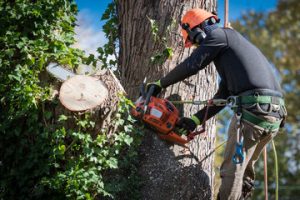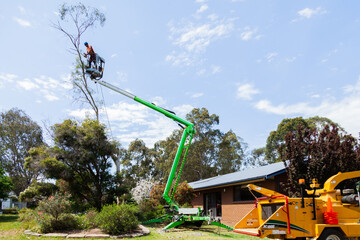Worcester Tree Removal requires careful planning to ensure safety and efficiency. Every tree has unique characteristics that affect how it is cut. Proper assessment prevents property damage and injury. The process is both technical and strategic.

Modern tree removal begins with a thorough inspection. Professionals evaluate trunk stability, root spread, and surrounding structures. They also check for disease or decay that may complicate removal. Accurate assessment guides every next step.
Safety is the highest priority during tree removal. Protective gear, ropes, and barriers reduce risk. Falling branches are controlled to prevent accidents. Planning the drop zone is critical before cutting begins.
Some trees are removed due to disease or infestation. Insects, fungi, or viruses can compromise structural integrity. Removing affected trees prevents spread to healthy plants. Early intervention maintains overall landscape health.
Urban tree removal requires special attention. Buildings, power lines, and sidewalks create additional hazards. Planners must account for these factors before any cuts. Precision prevents costly damage in crowded areas.
Equipment has evolved for safer, faster removal. Hydraulic lifts, chainsaws, and stump grinders are commonly used. Some jobs require cranes for large or precarious trees. Technology reduces labor while improving accuracy.
Tree removal is not only about cutting but also disposal. Debris must be safely removed or recycled. Wood can be repurposed for mulch, firewood, or furniture. Proper handling supports sustainability in landscaping.
Environmental considerations are crucial in removal decisions. Planners assess the impact on soil, wildlife, and water flow. Removing trees without strategy can cause erosion or habitat loss. Thoughtful planning balances human needs with nature.
Some trees are removed to make way for construction. Driveways, extensions, or utilities may require clearing. Professionals coordinate with builders to minimize delays. Strategic removal ensures both safety and project efficiency.
Pruning and trimming sometimes serve as alternatives. Selective removal of branches can relieve stress on weak trees. This extends the tree’s life while maintaining safety. Not all trees require full removal.
Root removal is an essential aspect of the process. Remaining stumps can sprout new growth or attract pests. Grinding or chemical treatments prevent regrowth. Proper root management ensures a clean, stable site.
Season affects tree removal planning. Winter may make soil firmer, reducing ground disturbance. Summer may allow faster drying of cut surfaces. Timing impacts both safety and efficiency.
Large trees require sectional removal for safety. Professionals cut branches and sections from the top down. This prevents sudden falls that could damage property. Careful sequencing protects both crew and surroundings.
Tree removal can increase sunlight and airflow. Clearing dense canopies improves conditions for remaining plants. It also reduces mold and moss growth on nearby surfaces. This creates healthier landscapes.
Planning includes assessing nearby structures and vegetation. Avoiding accidental damage to neighboring plants is part of the strategy. Professionals measure angles and distances precisely. Every cut is deliberate.
Some trees are removed to prevent future hazards. Leaning trees or those near power lines pose risks. Removing them proactively avoids emergency situations. Prevention is often safer and cheaper than reaction.
Permits are sometimes required for large or protected trees. Regulations ensure removal does not harm public spaces or ecosystems. Compliance protects property owners from legal issues. Professionals guide clients through these requirements.
Tree removal can improve aesthetics. Overgrown or dying trees may detract from landscaping design. Clearing them enhances sightlines and overall harmony. Gardens and yards feel more organized and inviting.
Some removal projects involve emergency response. Storm-damaged or uprooted trees need immediate attention. Quick action prevents additional property damage. Response teams prioritize safety and rapid clearing.
Tree removal can also intersect with wildlife management. Birds, squirrels, or other animals may inhabit trees. Professionals check for nests before cutting. Humane relocation ensures ecosystem balance.
Advanced techniques include rope-assisted cutting and crane lifts. These methods allow removal in tight or sensitive areas. Controlled lowering of branches prevents accidental impact. Technology increases both safety and efficiency.
Some trees require special disposal due to size or contamination. Treated wood, diseased material, or chemical exposure must be handled carefully. Proper disposal prevents environmental hazards. Responsible management protects soil and water.
Community spaces often require selective tree removal. Parks and playgrounds need safe and open areas. Removing unsafe trees improves public enjoyment and reduces liability. Planning balances safety with natural beauty.
Tree removal may involve soil restoration afterward. Ground left exposed can be compacted or eroded. Professionals prepare soil for new planting or turf. Proper restoration prevents long-term landscape issues.
Cabling and bracing can delay the need for removal. Weak trees may be reinforced to withstand stress. This technique supports growth while reducing risk. It is a proactive alternative to cutting.
Weather conditions affect removal decisions daily. High winds or rain make cutting dangerous. Professionals monitor forecasts to schedule safe operations. Safety protocols adapt to natural conditions.
Tree removal services are expanding with green initiatives. Wood chips, mulch, and logs are repurposed creatively. This reduces landfill waste and promotes sustainability. Every stage considers environmental responsibility.
Cost considerations include tree size, location, and complexity. Larger, urban, or hazardous trees require more labor and equipment. Clients plan budgets with expert consultation. Pricing reflects both risk and resources needed.
Some removals involve historic or heritage trees. Decisions require expert assessment and permits. Preservation efforts may guide partial removal instead of total cutting. Careful handling respects both history and safety.
Tree removal is also part of disaster preparedness. Overgrown or weak trees increase risk during storms. Removing them reduces potential damage to structures and people. Communities benefit from proactive planning.
Seasonal changes can influence tree health. Removing weakened trees before winter prevents snow or ice damage. Timely action keeps yards and streets safe. Professionals advise based on growth cycles.
Planners often coordinate with landscape designers. Clearing trees allows better design and planting plans. Removal is integrated into broader aesthetic and functional goals. Collaboration improves both safety and beauty.
Some trees require chemical treatment before removal. Pests, fungi, or rot may be managed before cutting. This prevents spread and protects nearby vegetation. Treatment ensures safer and cleaner removal.
Tree removal can support infrastructure projects. Roads, pipelines, and utility lines often require clearing. Coordination prevents delays and ensures safe progress. Planners balance efficiency with environmental care.
Professional arborists also consider long-term land stability. Removing large roots or trees affects soil composition. Experts advise on erosion prevention and replanting strategies. Proper planning maintains safe, stable grounds.
Tree removal may involve environmental mitigation. Replanting or creating buffer zones offsets ecological impact. Sustainability is increasingly part of project planning. Responsible removal balances human and natural needs.
Education is a part of tree removal services. Professionals inform clients about timing, risk, and maintenance. Knowledge empowers property owners to make informed decisions. Awareness reduces hazards and improves outcomes.
Advanced machinery allows tree removal in challenging terrains. Hillsides, urban alleys, and rooftops require specialized equipment. Machines enhance safety while reducing manual strain. Innovation keeps crews efficient and secure.
Tree removal is more than cutting wood; it is strategic planning. Safety, environmental care, aesthetics, and logistics all intersect. Each project requires expertise and foresight. Modern tree removal is both science and art.
